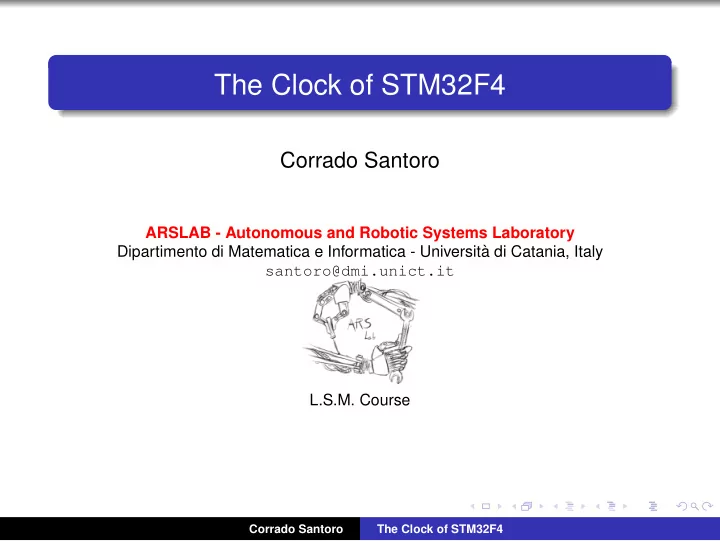

The Clock of STM32F4 Corrado Santoro ARSLAB - Autonomous and Robotic Systems Laboratory Dipartimento di Matematica e Informatica - Universit` a di Catania, Italy santoro@dmi.unict.it L.S.M. Course Corrado Santoro The Clock of STM32F4
STM32 and Clocks The STM32 has an internal clock circuit that has the objective of generating and distributing the clock signal for the CPU and all the peripherals The clock circuit is programmable, meaning that it can use different clock source and may apply division and multiplication factors Each family of STM32 MCUs has a different clock circuit with different features: here we consider the clock of STM32F4 Corrado Santoro The Clock of STM32F4
STM32F4: Clock Types and Sources The STM32F4 manages two different clock signals HS: High Speed LS: Low Speed Each clock signal is generated by clock source that can be: Internal: Generated by a Resistor-Capacitor net External: Generated by a quartz crystal resonator Therefore, we have the following signal names: HSI: High Speed Internal HSE: High Speed External LSI: Low Speed Internal LSE: Low Speed External Corrado Santoro The Clock of STM32F4
STM32F4: Clock Frequencies Low Speed Clock (LSI and LSE) must run at a fixed frequency of 32 . 768 KHz It is used to feed the Real-Time Clock circuit HSI (Internal High Speed) runs at a fixed frequency of 16 MHz HSE (External High Speed) can run at a frequency that goes from 4 MHz to 26 MHz Corrado Santoro The Clock of STM32F4
High Speed Clock: PLL The frequency of the HSI or HSE can be speed-up by using a circuit called PLL = Phase Locked Loop It is a standard circuit that can act as a frequency multiplier/divisor The PLL of the STM32 has two outputs and four factors N , M , P , Q f_in f_p / M x N / P f_q / Q N N f p = f in f q = f in M · P M · Q f q is the clock of USB and should be configured at 48 MHz Corrado Santoro The Clock of STM32F4
Clock Routing A multiplexer must be programmed to decide which kind of clock to send to CPU and peripherals: HSI HSE PLL In STM32F4 the selected clock cannot exceed 84 MHz Corrado Santoro The Clock of STM32F4
Clock Routing and Busses The selected clock signal feeds three internal busses: AHB , Advanced High-performace Bus, for CPU, Memory, DMA, GPIO APB1 , Advanced Peripheral Bus 1, some peripherals APB2 , Advanced Peripheral Bus 2, other peripherals Clock for APBx busses can be scaled by programming suitable prescalers Corrado Santoro The Clock of STM32F4
Clock Enable and Peripherals After having completed the configuration of clock circuit, the clock signal must be enabled for all peripherals used in our application There are three enable registers , each one for each bus AHBEN APB1EN APB2EN In each register, each bit controls the enabling of a specific peripherals Corrado Santoro The Clock of STM32F4
AHB Clock Enable Advance High-performance Bus (AHB) controls the following hardware resources DMA GPIO CRC Corrado Santoro The Clock of STM32F4
APB1 Clock Enable Advance Peripheral Bus 1 (APB) controls the following hardware resources I2C SPI Timers Watchdog USART Corrado Santoro The Clock of STM32F4
APB2 Clock Enable Advance Peripheral Bus 2 (APB) controls the following hardware resources SPI Timers ADC USART Corrado Santoro The Clock of STM32F4
The Clock of STM32F4 Corrado Santoro ARSLAB - Autonomous and Robotic Systems Laboratory Dipartimento di Matematica e Informatica - Universit` a di Catania, Italy santoro@dmi.unict.it L.S.M. Course Corrado Santoro The Clock of STM32F4
Recommend
More recommend